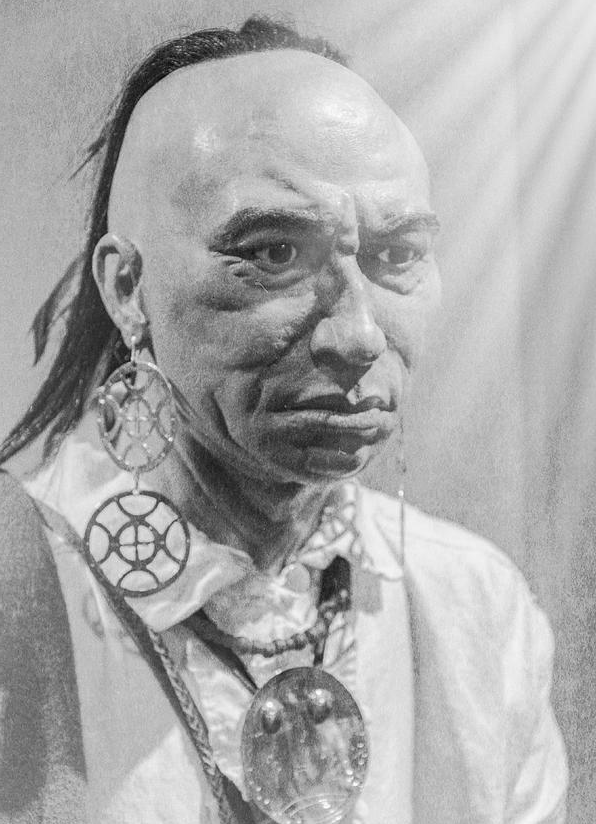
At the beginning of the eighteenth century the Cherokee were not a single political nation, but a linguistic and cultural grouping of about 50 villages. Dragging Canoe was born about 1730 somewhere in Tennessee. His father was Attakullakulla, a peace chief.
Dragging Canoe first appears in the written European histories in 1775 when the Transylvania Company met with the Cherokees in a treaty council at Sycamore Shoals on the Watauga River. The Transylvania Company, represented by Richard Henderson and Daniel Boone, wanted to acquire most of what is now Kentucky and middle Tennessee. The proposed treaty called for the Cherokee to give up a great deal of land in exchange for guns, ammunition, beads, trinkets, and blankets. The value of the goods was about $50,000.
Attakullakulla refused to sign and warned the colonists that a dark cloud now hung over the land. Other chiefs opposing the land sale were Dragging Canoe, Tuckasee, Terrapin, and Tanase Warrior. Dragging Canoe agreed to part of the sale but felt that the Cherokee should not part with the Cumberland, which he called the “bloody ground,” indicating that this was traditional hunting territory. Because of his opposition to the sale, Dragging Canoe left the conference. Withdrawing from a council was a traditional way of showing disagreement.
Boone plied the chiefs, including Oconostota and Attakullakulla, with whiskey. The chiefs were so drunk that the interpreter had to guide the hands of Oconostota and Raven Warrior as they signed the treaty known as the Sycamore Shoals Treaty. With this treaty, the Cherokee lost their traditional Kentucky hunting grounds. Journalist Stanley Hoig, in his book The Cherokees and Their Chiefs: In the Wake of Empire, writes: “The Transylvania purchase marked not only the beginning of Cherokee resistance to the loss of their land but also the decline of tribal influence for the old chiefs.”
The American Revolution began in 1776 and both the American rebels and the British sought Indian allies in this war. Emissaries from the Iroquois, Shawnee, Delaware, and Ottawa travelled to the Muscle Shoals on the Tennessee River to meet with the Cherokee and to persuade them to form an alliance against the American revolutionaries. Shawnee leader Cornstalk told them: “It is better for the red men to die like warriors than to diminish away by inches. Now is the time to begin. If we fight like men, we may hope to enlarge our bounds.”
The Shawnee produced a wampum War Belt which was about nine feet long. Dragging Canoe accepted the belt and the warriors joined him in singing a war song. In spite of the persuasive words of the northern Indians, however, the Cherokee remained divided on this issue. The older Cherokee, such as Attakullakulla and Oconostota, objected to the war; but some of the younger warriors, such as Dragging Canoe, Doublehead, Young Tassel, and Bloody Fellow, sided with Cornstalk.
Dragging Canoe led a war into Kentucky and returned with four scalps. He then began making plans to attack the colonists. Nancy Ward, wanting to protect the colonists who had befriended the Cherokee, secretly warned some of the traders. As a result the colonial settlements began building forts. Two hundred warriors under the leadership of Dragging Canoe and Abram set out to attack the Kentucky settlements. The colonists repulsed the first attack, killing 13 Cherokee and wounding Dragging Canoe. As the Cherokee withdrew, they burned a number of isolated cabins in the area and took 18 scalps.
The American response to the Cherokee attacks called for them to be driven from the country. Thomas Jefferson declared: “I hope the Cherokees will now be driven beyond the Mississipi [sic]”
Historian Colin Calloway, in his book The American Revolution in Indian Country: Crisis and Diversity in Native American Communities, reports: “The Cherokees had forfeited their rights to their land: private seizures of Indian lands, illegal before the war, now became a patriotic act.”
American forces from North Carolina and Virginia, with the aid of Catawba scouts, invaded Cherokee country. Thirty-six towns, along with their cornfields and livestock, were destroyed. South Carolina offered a bounty of 50 pounds for each Cherokee scalp and 100 pounds for each Cherokee prisoner. In Georgia, American forces (the Georgia Militia) attacked Cherokee towns seeking the complete destruction of the Cherokee nation. They burned homes, destroyed crops, and indiscriminately killed men, women, and children.
While the Cherokee national council urged neutrality in the war between the colonies and England, eleven Cherokee towns withdrew from the council and allied themselves with the British.
In 1777, representatives from the State of Virginia negotiated a peace treaty with the Cherokee in which the Cherokee admitted defeat, ceded their lands east of the Unicoi Mountains, and agreed to give up prisoners, including black slaves. Dragging Canoe, however, refused to honor the treaty and withdrew to the Chickamauga Creek area. Dragging Canoe’s people were thus known as the Chickamauga.
In 1778, Cherokee warriors from the Chickamauga towns under the leadership of Dragging Canoe joined British forces to fight against the American rebels in Georgia and South Carolina. The Americans, taking advantage of the absence of the Cherokee warriors, attacked the Chickamauga towns. Cherokee historian Robert Conley, in his book The Cherokee Nation: A History, reports: “The brave troops totally destroyed eleven towns without much effort, for Dragging Canoe and all the fighting men were away from home.” Most of the women and children escaped to the woods and only four Cherokee were killed. The Americans captured 20,000 bushels of corn as well as ammunition.
In 1779, the Chickamauga under the leadership of Dragging Canoe established five new towns near Lookout Mountain in Tennessee: Nickajack, Running Water, Lookout Town, Long Island, and Crowtown. The towns were protected and provided Dragging Canoe and his warriors a base from which they could attack the American frontier settlements. In addition to Dragging Canoe, the other Cherokee leaders at this time include Doublehead, Pumpkin Boy, Bench (also known as Bob Benge), Will Webber, Bloody Fellow, the Bowl, Middlestriker, John Watts, Little Owl, and the Badger.
In 1780, Dragging Canoe led his Cherokee warriors in raids against a number of American frontier towns. The Americans retaliated by burning the Cherokee village of Chota in Tennessee. In their attacks against the Overhill Cherokee, the Americans claimed to have destroyed 50,000 bushels of corn and 1,000 houses. While Dragging Canoe’s Chickamauga were allied with the British, the Overhill Cherokee were actually American allies. The Americans, it would seem, were unable to determine which Cherokee towns were allied and which were enemies.
In 1782, the newly formed United States and the British obtained a provisional peace, ending the Revolutionary War. The British army returned home to England. However, Dragging Canoe continued his fight against the Americans even though the British had left. Cherokee historian Robert Conley writes: “He continued to talk with representatives of other Indian tribes with the goal of forming a confederation of all tribes to hold back further encroachment of Americans onto Indian land.” Dragging Canoe met with the Choctaw, Creek, Shawnee, Chickasaw, and other tribes.
In 1788, Dragging Canoe’s Cherokee warriors attacked American troops at the Hiwassee River in Tennessee and obliged them to retreat. The following year, American forces defeated the Cherokee under the leadership of Dragging Canoe at the battle of Flint Creek, Alabama.
In 1791, the Cherokee signed the Treaty of Holston which was intended to end hostilities between the United States and the Cherokee. The treaty gave the United States the exclusive right to trade with the Cherokee and prohibited the Cherokee from entering into diplomatic relations with other foreign powers, individual, or state. Signing the treaty for the Cherokee were Dragging Canoe, Bloody Fellow, Doublehead, Lying Fawn, John Watts, and Little Turkey.
The treaty called for the United States to advance civilization among the Cherokees by giving them farm tools and technical advice. The United States promised that the land remaining to the Cherokee would be theirs forever. In addressing Cherokee concerns over settlers, Article VIII gave the Cherokee the power to punish United States citizens who settled on Cherokee lands. The treaty states: “If any person, not an Indian, shall settle on any of the Cherokees’ lands, he shall forfeit the protection of the United States, and the Cherokees may punish him.”
In 1792, Cherokee leader Dragging Canoe died. John Watts assumed his leadership position.
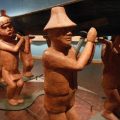
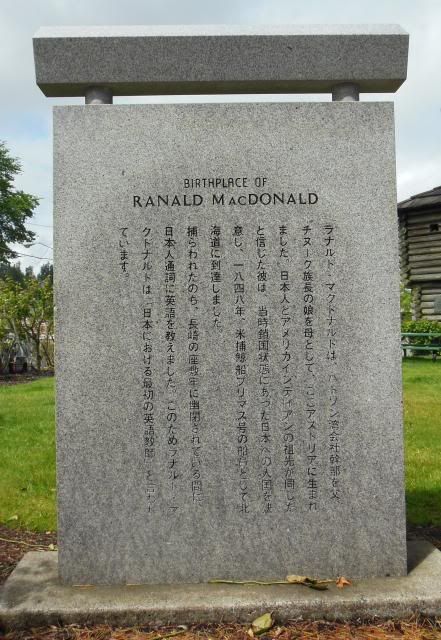
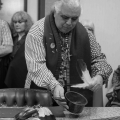
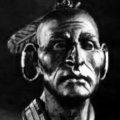
Hi
Thank you for the intersting article.
My family lived in northern Georgia before removal. I was wondering if you had heard of them. Sittingdown, Settendown. Also Buzzard.